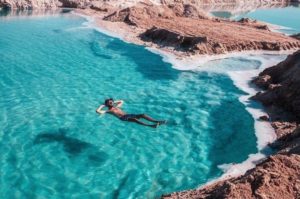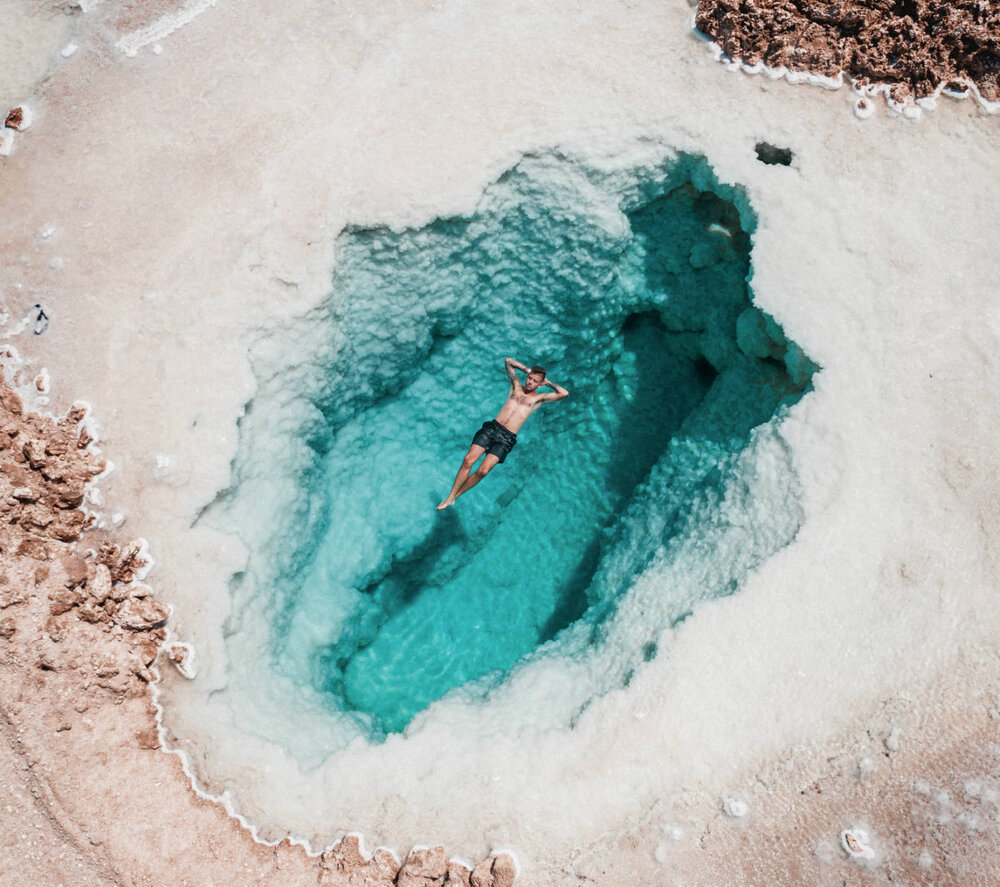Siwa Oasis salt lakes
Siwa Oasis is located 562 km from Cairo, Egypt Siwa’s salt lakes: beautiful and healing
Each natural pool lake is four meters in depth, but you cannot drown in it due to the heavy capacity of this water, as there is a large amount of natural salt mixed in it.
Best time to visit Siwa Oasis is October to March, avoid the weekends and take 3 days – 5
Getting to Siwa Oasis from Cairo
⏩ BY FLIGHT ✈︎
Fastest way to get to siwa Oasis is by flight details below
- The closest airport to Siwa is in Marsa Matruh which is still about four hours away. You could fly to Marsa Matruh and then arrange ground transportation from there. Many hotels in Marsa Matrouh offer day trips to Siwa salt pools.
- EGYPT AIR Flights operate from May-September
Cairo-Marsa Matrouh Departs on Sundays and Wednesdays
Marsa Matrouh-Cairo Departs on Sundays and Wednesdays - THOMSON AIRWAYS Flights operate from April-October
London Gatwick-Marsa Matrouh Departs on Tuesdays
Marsa Matrouh-London Gatwick Departs on Tuesdays
Manchester-Marsa Matrouh Departs on Tuesdays
Marsa Matrouh-Manchester Departs on Tuesdays - EDELWEISS AIR Flights operate from July-October
Zurich-Marsa Matrouh Departs on Sundays
Marsa Matrouh-Zurich Departs on Sundays
⏩ BY BUS 🚌
Cairo to siwa Oasis by bus takes 12 hours but easy, safe and cheap.
Getting to Siwa by bus from Cairo (nightly bus) departs daily 6:45 pm from Torgoman bus station and arrives Siwa at 6:00 am. You can take the same bus back to Cairo at 8:00 Pm from Siwa bus station and the rate starts from 60 EGP
Torgoman station or also known as Cairo Gateway Bus Station, the terminal is located at the ground level of the bus station (it is well marked in English and Arabic).
The terminal is located at the ground level of the bus station (it is well marked in English and Arabic).
The place to buy ticket is located at the main entrance of the bus station. When you enter the station, you have to go through security checkpoint like the one in airports. Then you will be presented with multiple windows (on the left and right side of the entrance hall) with various bus station companies that go to different destinations in Egypt.
The bus company that goes to Siwa is on the left hand side called West Delta
How to get to Turgomen Bus Station/Cairo Gateway Bus Station
- From Zamalek: Call up a taxi and tell him that you are going to Turgomen. The price will be 10 EGP. If the traffic jam is not so bad, you will reach the station in 15 minutes.
- From Dokki: Call up a taxi and tell him you are going to Turgomen.The price will be around 12 – 15 EGP. If the traffic jam is not so bad, you will reach the station in 20 minutes.
- From Downtown: You can walk. It will take you 20 minutes. If you call a taxi, the price will be around 5 EGP.
- We recommend bringing torch and wet toilet wipes for the journey. The torch may be needed due to some pit stop bathroom has no light
- ONCE YOU ARRIVE SIWA ARRANGE it can be difficult to find taxis or tuk tuks to get you to the salt pools or even getting around . What I suggest is arranging a driver with your hotel. Don’t expect to just walk outside and see taxis looking for customers.
⏩ BY TOUR 🚕
We recommend taking a guided tour as a road to Siwa is quite long and tiring to do by yourself, hiring a private driver could be a good option, but keep in mind you will need to pay for their food, accommodation and services. The costs can add up for this option.
You can also rent a car if you are comfortable driving in Egypt. Make sure you bring your international driving permit/licence along for the journey.
Below is a guided tour from Cairo
Situated in the Western desert, the Siwa Oasis has a continental climate that is quite hot in the summertime and in all times of the day. While the wintertime and the springtime in the mornings the weather is warm and beautiful. However, the nights are very cold in some periods, this is because of the desert atmosphere.
According to scientific research dating from the beginning of the last century, Siwa oasis was populated in prehistoric times by people who came from civilisations further west. Their culture and way of life shared much with those of Libya, North Africa and the Nile valley.
Since ancient times, from the Greek to Roman eras and on to the Middle Ages, the oasis was referred to by a variety of names as witnessed by various inscriptions unearthed in temples and on tombs. The more recent name Siwa was derived from the name of the indigenous Ti-Swa tribe.
The ancient oasis of Siwa was crucial to the trade caravans which crossed the desert from the Nile valley in the east to the Mediterranean harbours of Libya in the west. Such was its importance that traders from the southern oases and central Africa were frequent visitors. Siwa also prospered as a religious centre, with many kings sending delegates to consult the Oracle of Amun.
The era of the 26th Dynasty drew to a close with the invasion of a Persian army led by Cambesis – though his 50,000-strong force was later to vanish in a desert sandstorm, leaving no trace behind.
The Oracle of Amun derives much of its fame from Alexander the Great’s visit in 331 BC. After consulting the oracle, he claimed to be the son of the god Zeus Amun, and so chose to be buried in Siwa.
Siwa started to go into decline around the sixth century AD, when many of the pagan temples in Siwa fell out of use thanks to the spread of Christianity. This period coincided with the collapse of the Roman Empire and the area’s degeneration into anarchy which culminated in the Arabian invasion of Egypt in 640 AD.
At the height of Siwa’s glory, change was swift and the rewards to victorious assailants were potentially very high. In the eighth century, the Arabian army arrived to conquer Siwa. The inhabitants, an ancient tribe of Amazigh people under Roman rule, were confronted by the Arabian army and given three choices; one, to join the Arabians, two, to pay them tribute and live in peace, or three, to fight for their land.
The clever natives bought themselves time by asking for three days to choose their answer. During this three-day period they gathered together all their riches (such as gold, jewellery, precious stones, and Pharaonic treasures). Then, on the last day, they fled west with all they could carry. Leaving all their heaviest treasures behind, they hid them from the Arabian soldiers and cast spells so that they would be guarded in their absence by the magical powers of their genie.
At the time, there was a drought throughout the countries of northwestern Africa, so the Amazigh people set off eastwards, in caravan formation, searching for grass and water. Then, travelling through the scorching sands of the Western Desert, they found the answer to their dreams – the beautiful oasis of Siwa, with natural springs and fields of apricot, olive, and palm trees, all singing with life.
The Amazigh people decided to make their home here and sent word back west to Algeria and Morocco for their families to come and join them to strengthen the tribe’s power and claim on this fertile land.
The first city was named Ami Misalum and built in the lowlands of the oasis. However, this left the Amazigh vulnerable both to attacks from hostile forces and to mosquitoes. So, in 1103 AD they built a strong citadel on the hilltop to protect themselves and their unique culture and made this their kingdom.
New laws and rules were instituted which, along with the more secure location, allowed the tribal chiefs to govern Siwa as an independent state for hundreds of years. For example, in order to irrigate their lands throughout the night, gardeners had to seek permission from the chiefs before the Zagala (‘strong youth’) guards would open up sthe citadel’s doors.
In 1840, however, the independence of Siwa was challenged by the famed tyrant and Turkish ruler, Mohamed Ali. He sent his Egyptian army to Siwa, seeking tribute and the submission of its people to his rule. The Siwans dug a trench around the base of Shali to prevent the Egyptian army from attacking, but Ali fired rockets at the citadel, causing great destruction. He also commanded General Hussein Bek Ashamashurgi to invite seventy-two of the highest local chieftains to a meeting where they were promptly killed. So the Siwans were forced to submit.
a new system of Egyptian government was imposed and the Siwans suffered many hardships, such as paying a one piastre tax for every palm tree in the oasis. This continued until 1950 when a Bedouin businessman bought all the dates in Siwa and paid all the state taxes on the trees.
The police chief responsible for the administration of Siwa, El Misseri, then took control of the oasis. The Siwan people had grown dates from the palm trees to feed the poor and to send money to Mecca to help the nation of Islam. But under Misseri’s control, the sheikhs were forced to sign over the trees to him and he took the proceeds from the sale of the dates for his own gain. This lasted for four years.
The new challenge for Siwa was how to open up to the world. In 1977, president Mohamed Anwar Sadat visited the oasis and showed great sympathy towards the people. Later, in 1983, he gave the Siwans a helicopter to make access to the rest of Egypt easier. This helicopter was for medical purposes and the transport of necessary commodities. (I had the chance to fly in this helicopter when I was just baby Mohamed.) We now have educational support with many schools, starting from elementary school, all the way to preparation for university. The provision of child and youth services and activities was also instituted.
Siwa’s changing fortunes have been reflected in the fluctuations of its population levels, from forty in the twelfth century AD to some three thousand at the time of Mohammed Ali’s invasion in 1805. Siwa continues to expand, and the population is currently calculated to be around twenty thousand and growing.


